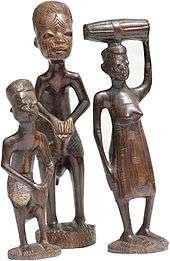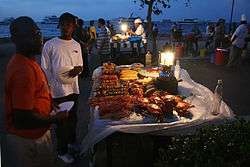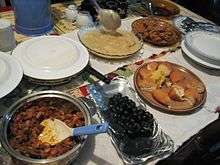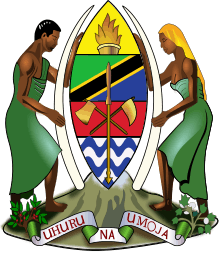Culture of Tanzania
| Part of a series on the |
| Culture of Tanzania |
|---|
 |
| History |
| People |
| Languages |
| Religion |
|
Music and performing arts |
| Sport |
|
Monuments |
|
Symbols |
|

Languages
A total of 130 languages are spoken in Tanzania, most of them are from the Bantu family.[1] Swahili and English are the two official languages of Tanzania. However, Swahili is the national language.[2]
Given the conditions of the period, it was not possible to introduce Swahili in the entire educational system, because the scale of the task of writing or translating textbooks for primary schools was already considerable. As a result, English, the colonial language since the end of World War I, is still the language of high schools and universities. Many students leave school after finishing primary education.
Although the many non-official languages in Tanzania are not actively suppressed, they do not enjoy the same linguistic rights as Swahili and English. They also face language extinction, with one, the Kw'adza language, having no remaining speakers.[1]
Literature
Some writers include:
Media
Music
National anthem
The Tanzanian national anthem is Mungu Ibariki Afrika (God Bless Africa), composed by South Africa's composer Enoch Sontonga. The song is also the national anthem of South Africa (with another tune), Zambia.
Music industry
The music industry in Tanzania has seen many changes in the past ten years. With a fusion of local and foreign music traditions, Tanzanian musicians have grown in prominence within the African Great Lakes region. It includes artists from traditional music, such as Dionys Mbilinyi, Sabinus Komba, and many others, to new vibrant artists in R&B, pop, Zouk, Taarab, and dance.
Imani Sanga is a composer, ethnomusicologist, church organist, and choral conductor.
Mwakisinini Felix is a music artist who contributed a lot in church music as a composer, trainer, and choral conductor.
Arts
Painting
Tingatinga are popular Tanzanian paintings, which are painted with enamel paints on canvas. Usually, the motifs are animals and flowers in colorful and repetitive design. The style was started by Mr. Edward Saidi Tingatinga, who was born in South Tanzania. Later, he moved to Dar es Salaam. Since his death in 1972, the Tingatinga style expanded both in Tanzania and worldwide. One of the most famous African artists, George Lilanga, was born in Tanzania. Other recognized Tanzanian abstract artists include David Mzuguno, Haji Chilonga, Salum Kambi, Max Kamundi, Thobias Minzi, Robino Ntila, John Kilaka, Godfrey Semwaiko, Evarist Chikawe, and many others (see also: http://www.artshost.org/rafiki).
Cartoon
Tanzania's cartoons have a history that can be traced back to the work of pioneering artists, such as Christian Gregory with his Chakubanga cartoons in the Uhuru newspaper back in the 1970s and 1980s, and Philip Ndunguru in the early 1980s. Outspokenly political cartoons were created on a more recent date.
In the past decade, the art of cartoons and comics has really taken off in Tanzania. At the present date, there are dozens of cartoonists, some of whom are well known throughout the country. From the 1960s and so on, a number of artists prepared the way, and their names are cited by today's artists as essential influences. Some of these known cartoonists in Tanzania include Ally Masoud 'kipanya', Sammi Mwamkinga, Nathan Mpangala 'Kijasti', King kinya, Adam Lutta, Fred Halla, James Gayo, Robert Mwampembwa, Francis Bonda, Popa Matumula, Noah Yongolo, Oscar Makoye, Fadhili Mohamed, and many others (see the excellent history of cartoons in Tanzania at the Worldcomics website: http://www.worldcomics.fi)
Sculpture
George Lilanga, who died in 2005, was one of Tanzania's most famous sculptors. People in Tanzania often sculpt images of people and animals, usually out of clay or a metal.
Sports
Cuisine


Tanzanian cuisine is both unique and widely varied. Along the coastal regions (Dar es Salaam, Tanga, Bagamoyo, Zanzibar, and Pemba), spicy foods are common, and there is also much use of coconut milk. Regions in Tanzania's mainland also have their own unique foods. Some typical mainland Tanzanian foods include wali (rice), ugali (maize porridge), chapati (a kind of bread), nyama choma (grilled meat), mshikaki (marinated beef), samaki (fish), pilau, biriyani, and ndizi-nyama (plantains with meat). Vegetables commonly used in Tanzania include bamia (okra), mchicha (a kind of spinach), njegere (green peas), maharage (beans), and kisamvu (cassava leaves). Tanzania grows at least 17 different types of bananas which is used for soup, stew, and chips.
Famous Tanzanian snack foods include maandazi (fried dough), isheti, kashata (coconut bars), kabaab (kebab), sambusa (samosa), mkate wa kumimina (Zanzibari rice bread), vileja, vitumbua (rice patties), bagia, and many others.
Since a large proportion of Indians have migrated into Tanzania, a considerable proportion of Tanzanian cuisine has been influenced by Indian cuisine. Famous chefs, such as Mohsin Asharia, have revolutionized traditional Indian dishes, such as kashata korma tabsi and voodo aloo. Many Indians own restaurants in the heart of Dar es Salaam, and have been welcomed by indigenous Tanzanians.
See also
- Tinga Tinga painting - Brightly colored and whimsical nature art indigenous to Tanzania
- Religion in Tanzania
- List of African cuisines
References
- 1 2 "Ethnologue report for Tanzania". Ethnologue.com. Archived from the original on 2012-01-11. Retrieved 2012-01-28.
- ↑ "Tanzania National Website". Tanzania.go.tz. Archived from the original on 2001-04-17. Retrieved 2012-01-28.
